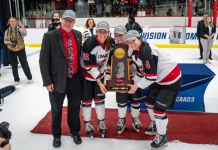It has been an unprecedented 18 months in women’s hockey. No, not because of the pandemic – or at least, not directly. In just over a year (381 days) from August 20, 2021 to September 4, 2022, players on their respective countries’ senior national teams played in three major tournaments – two World Championships and an Olympics. The 2022 tournament was the first time the IIHF Women’s World Championships had been played in an Olympic year.
Taking that further, in March 2021, players like Wisconsin’s Lacey Eden, Ohio State’s Emma Maltais and UMD’s Ashton Bell played in the Frozen Four to start the month. From there, they went also immediately into selection camps for their respective countries in order to vie for a spot on the 2021 World Championship team. They entered centralization and spent the above-mentioned 53 weeks practicing and playing at the highest level. There was a small break following the Olympics before players were back at the National Festival/selection camp in advance of the second World Championship.
Players for countries that didn’t centralize, like Northeastern’s Alina Muller (Switzerland) and St. Cloud State’s Jenniina Nylund (Finland), participated in those international tournaments while also continuing to play a full NCAA schedule.
The 2002 World Championship gold medal game was on September 4. NCAA schools were able to be on the ice the first day of classes, which for most schools was somewhere between Aug 22 and September 6. College teams obviously gave returning players a rest, though in preseason media calls a number of them said the players were eager to be on the ice.
Though their schedule wasn’t quite so rigorous, many of the oldest players on the US and Canada rosters at the U18 Women’s World Championship in June were planning to go right from that tournament to their college campuses. A number of US players missed their high school graduation ceremonies to be in Madison. In the case of the Wisconsin commits, they went to campus for the World Championship and then went right into summer school classes and training programs. Move in was immediately following the close of the tournament at a number of universities.
The players would all tell you that none of these things have been an issue and that they are just happy the tournaments took place and they were able to play.
In college hockey, we see the intersection of one of the longest seasons for any NCAA sport with some of the most physically demanding games. Even under the most well-rested and prepared circumstances, the season takes its toll.
It seems impossible that the rigor of the last 18 months won’t have an effect on these players.
My concerns about this have lingered in the back of my mind since I started talking to coaches about it on preseason phone calls, but was brought to the forefront again this week when Olympique Lyonnais and French National Team player Wendie Renard was quoted in the French newspaper L’equipe talking about fatigue and injuries.
Women’s soccer players ended their season in Europe in June and had about a month before they played in the 2022 UEFA European Women’s Football Championship (Euros) through the month of July. Two weeks later, Olympique Lyonnais was back on the pitch for the warm up to the season. The players were back with international teams this past week for friendly games in the ramp up to World Cup 2023.
Paraphrasing from the French, she said, “We must not forget that we are human beings and that at certain times we need to recover, if only psychologically.”
Boston College coach Katie Crowley, who skated in three Olympics and six World Championships, told me before the 2022 Worlds gold medal game that the big tournaments take more out of you. She called them grueling and exhausting.
In this day and age, mental health should be a focus among all programs at all times. But in light of the death of a number of female student-athletes by suicide, I hope women’s sports teams on campuses are receiving even more care and support. And I hope the women who returned to campuses
I had been worried about an increase in injuries to tired, overworked bodies. Renard’s comments about the physiological toll of being “on” and expected to be your best with little to no rest showed that the concern here needs to be about so much more than muscles or tendons.


